www.johntyman.com/peru/14.html
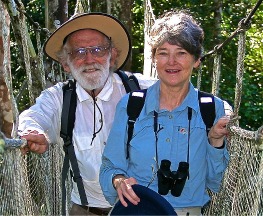 |
CULTURES IN CONTEXT PERU The Incas and Prehistoric Cultures IV: INCA CULTURE 4.5: Cuzco |
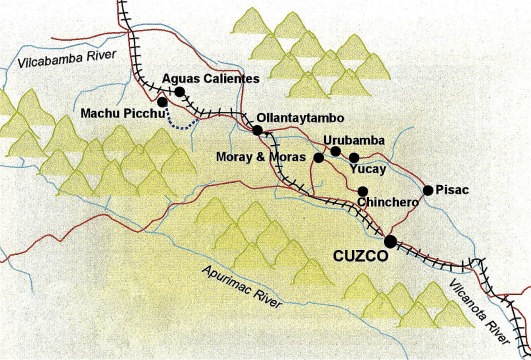
143. Though the Incan empire extended the entire length of the coast of the modern Peru (including today’s national capital Lima), the most impressive ruins all lie inland in the foothills of the Andes, in the valley of the Urubamba River … in the “Sacred Valley”. Pisac, Moray, Maras, Ollantaytambo, and Machu Picchu are all positioned close to this river, and Cuzco 20kms south of it. (Map courtesy “South America Travel Centre”) |
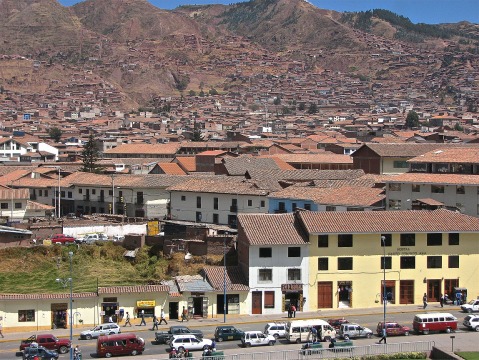
144. Cuzco, at a height of 3,400 metres, was the capital of the Inca Empire from the 13th century to the 16th, when it was sacked by Pizarro in 1535. It was originally divided into two mains parts, High and Low Cuzco, and subdivided into thirteen neighbourhoods. The streets were paved, and the city was equipped with water and sewage systems. (View from the forecourt of today’s nunnery.) |
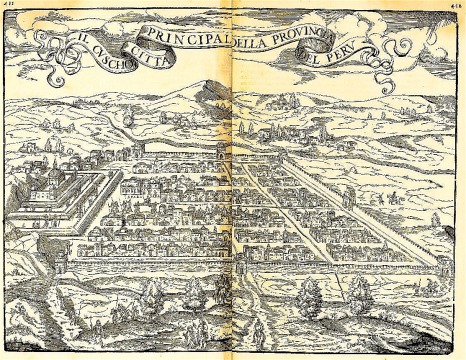
145. Each local Inca leader was required to build a house in the city and live part of the year in Cuzco. The city was constructed according to a definite plan, with a grid of roads and long lines of buildings. The great square was surrounded by gold-plated palaces, since each sovereign built a new palace for himself to live in. The plaza also functioned as the hub for the four principal roads that led to the empire’s four territorial divisions, or suyus. (Plan of the city in 1565.) |
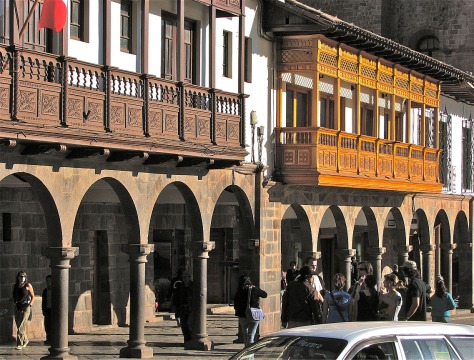
146. Central Cuzco was home to the families of royal blood, the priests, the military, and a host of administrators. Later this was where the conquistadors and colonial government officials lived, in houses of wood and stone like these … a blend of Indian and Spanish styles.(Street in the centre of town. See also frame 127.) |
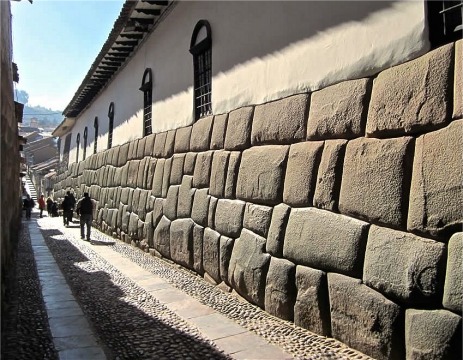
147. The Spanish destroyed many Inca buildings, incorporating the remains of their walls in the construction of a new city, replacing temples with Catholic churches and palaces with mansions for conquistadors to live in. Only the outlines of city blocks remain, together with walls of the magnificent buildings that once filled the capital. Walls here, as usual, were built of finely worked stone blocks, still surviving on either side of some streets. |
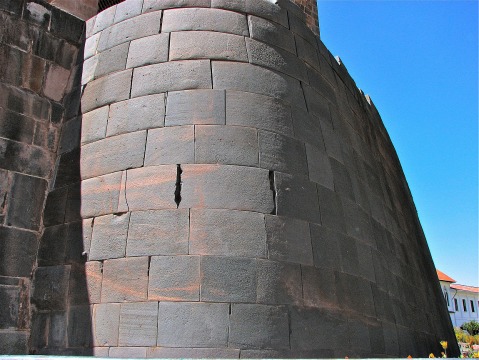
148. The finest of these walls were part of the Qorikancha, meaning “Golden Courtyard” in the language of the Quechua Indians. It was originally named Intikancha since it was dedicated to the sun god Inti. As “The Temple of the Sun” it was the most important temple in the Inca Empire. It was built of stones of similar size, perfect, without the slightest imperfection. According to Inca mythology this is the spot where Manco Capac founded the city of Cuzco and the subsequent Inca Empire. (Foundations of the temple.) |
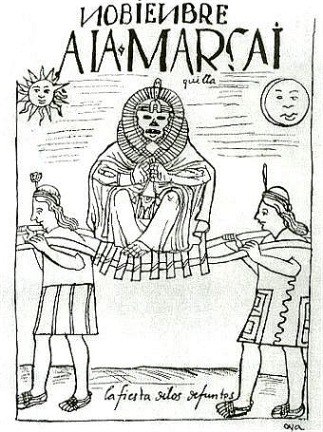
149. Inca Yupanqui, the tenth Inca ruler (1471 to 1493), rebuilt Cuzco, enriching the Temple of the Sun, covering its walls with sheets of gold and providing vases of gold and silver for the Mama-cunas (nuns) to use in services of veneration. Finally, he took the bodies of the deceased Incas, provided them with masks, headdresses, bracelets, and sceptres of gold, and placed them on a golden bench. None of them remain, because royal mummies were burnt by the Spanish who considered them heretical. (Mummies were paraded through the streets during the Festival of the Dead.) |
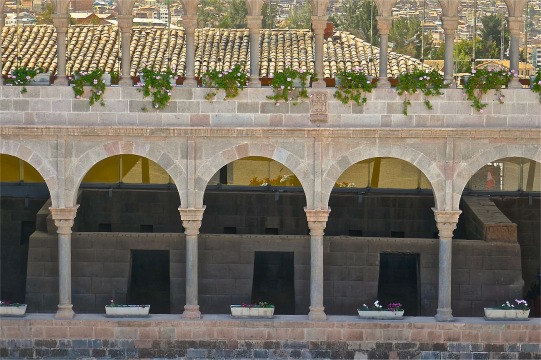
150. The courtyard adjacent to the temple was also filled with golden statues. Spanish reports noted that the opulence of the temple was "fabulous beyond belief". And when the Spaniards demanded a ransom for the life of the Inca leader Atahualpa, estimated to be worth $30-50 million today, most of this gold came from the Qorikancha. It served to fan the fires of gold fever; and seven hundred loads of gold were eventually looted from sites throughout the empire. (Part of courtyard within later Catholic nunnery.) |
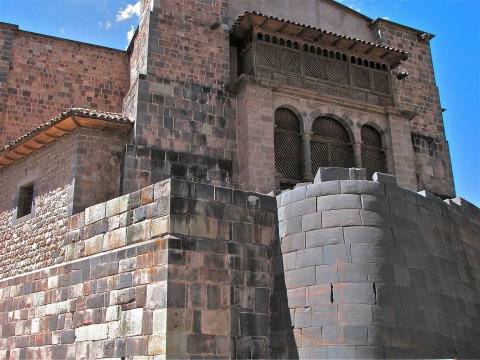
151. The Spanish colonists demolished the temple and the old House of the Virgins and built the Convent of Santo Domingo (a rather different nunnery!) over its foundations. It was the first of numerous sites where the Spanish incorporated Inca stonework into the structure of a colonial building. Interestingly, although major earthquakes later severely damaged the church and nunnery, the Inca stone walls remained intact. (Convent and church built on the site of the Temple of the Sun and the House of the Virgins.) |
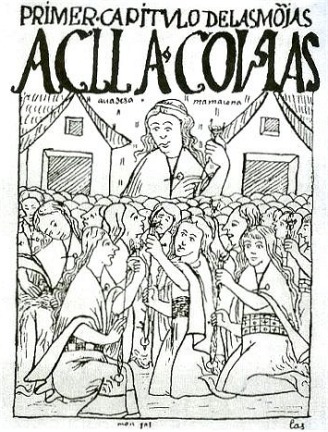
152. In his Chronicle Guaman Poma notes that Cuzco’s “House of the Chosen Ones” was “where the Sun Virgins lived. (Also that) there were six types of virgins who served the idols and another six types of common virgins who served in the royal inns, the seed beds and in the manufacture of clothing”. (Drawing of an Aclla Huasi.) |
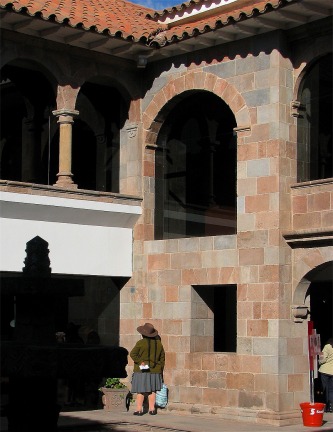
153. Today the Spanish colonial era dwellings at the centre of the city are a secondary focus for tourism. Several of the more impressive homes have been turned into banks (like this), museums, or expensive gift shops. The homes of the conquistadors typically had doorways tall enough that they could be entered on horseback. (Present day bank) |
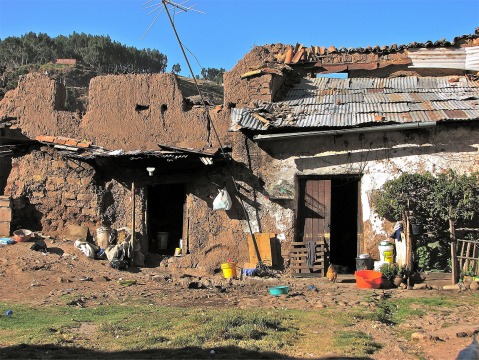
154. Beyond the city centre were the neighbourhoods of people who had been transported from other parts on the Empire to meet the needs of government. In common with the bulk of the local Indian population most of them lived in houses made of adobe or unworked stone, with sloping roofs covered with straw, which have deteriorated over time. |
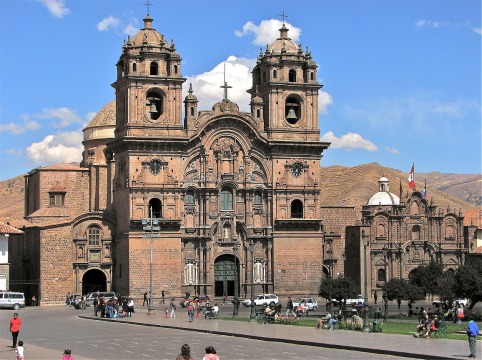
155. The Catholic bishop appointed to Cuzco after its conquest by the Spanish built his cathedral on what is now known as the Plaza de Armas, which is but a fraction in size of the original square. From here he directed the evangelization of the Incas and their neighbours. Not only did their beliefs change, their way of life did too … though, today, on both spiritual and material levels the marks of Inca traditions are visible still. |
![]()
Text and photos by John Tyman
Intended for Educational Use Only.
Contact Dr. John Tyman at johntyman2@gmail.com
for information regarding public or commercial
use.
![]()
www.hillmanweb.com
Photo processing, Web page layout, formatting
and hosting by
William
Hillman ~ Brandon, Manitoba ~ Canada